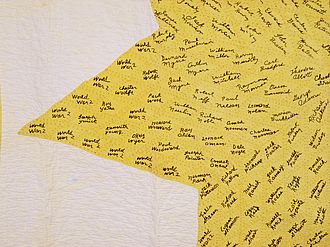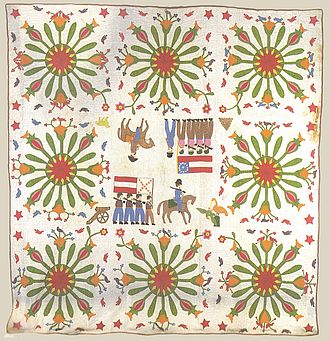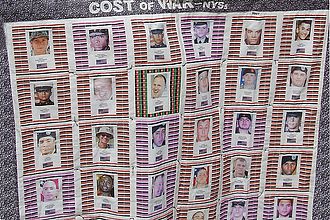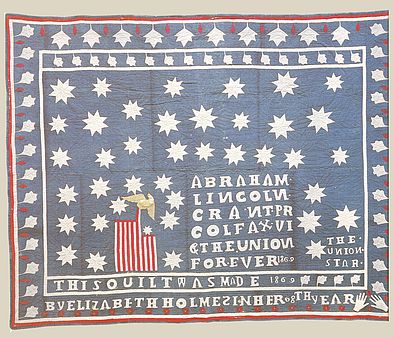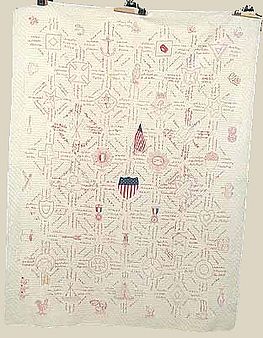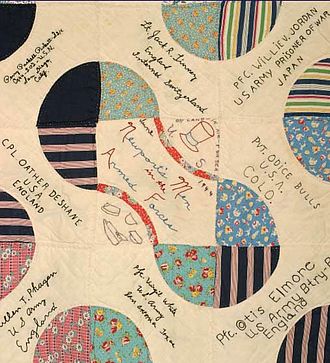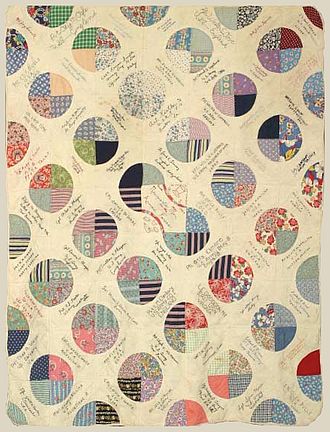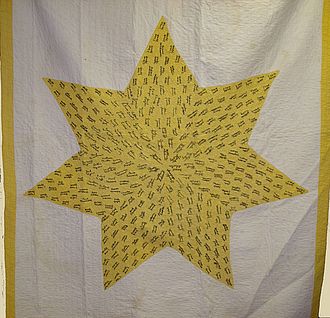Quilt Designs
Beyond the communal process of quilting, stories about quilts and their designs commemorate war and women’s experiences with war in overt ways. Quilts allowed women to record war and battle with political perspectives. According to Ferrero, Hedges, and Silber, “from being expressions of women’s private lives, testaments to domestic allegiance, quilts had also become in the course of the century political emblems and acts that helped women to expand their world and thus to negotiate their transition into modern times."36 Susan Robb depicted Confederate battle glory in her intricate appliqué quilt. Careful stitches illustrate ranked soldiers marching under two versions of the Confederate flag. The image of a stork overpowering an eagle is reminiscent of an emblem on Constitutional currency and represents the power of the South early in the War.37
Quilts also commemorate war protest. Betty Wood created quilts to communicate her disapproval of the war in Iraq. In an effort to place names and faces with otherwise nameless and faceless classified casualties, Wood illustrated photographs and I.D.s surrounded by American flags depicting coffins.38 Political messages in quilts both honored and protested war.
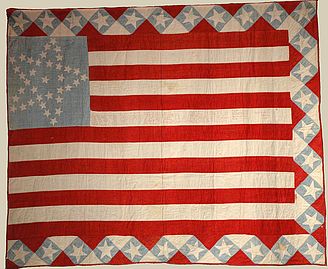
Political quilts often listed achievements. Mrs. Alfred Van Fleet of Illinois created a commemorative quilt one year following the Civil War. The quilt became a sort of honor roll to record her husband’s name, military rank, and the battles in which he fought between 1863 and 1864, stitched in a white strip of the American flag design. The litany of forty-seven battles in Virginia, Pennsylvania, and Maryland became her own badge of courage as she sustained him and held the home and family together in his absence. Her effort to remember her husband’s achievements and to stitch them indelibly in the fabric of her quilt demonstrates her own participation.39
Elizabeth Holmes’s patriotic quilt illustrates similar political sentiments, inscribing her name in public allegiance to the support of Lincoln and Grant dated four years after Lincoln’s assassination and certainly well before she could cast her own vote.40 Holmes fashioned her political memory through her quilt. Twenty years after the Civil War, Mary Morgan coordinated the efforts of the Women’s Relief Corps in 1883 to make a quilt with one embroidered square for each corps of the Union Army (Appendix, 16). The quilt was probably made for a fundraiser for surviving veterans, with scattered GAR initials referring to the Grand Army of the Republic.41 The creation of unique insignias for each corps reflects their iconographic memory as well as present needs to remember at the time of the quilt’s creation.
Roll call quilts were also popular during World War II.42 Women in Newport, Texas, made a quilt commemorating the soldiers from their local community. Names, ranks, and locations are carefully stitched into the blocks. Mrs. Earl E. Schaeffer sewed a “Gold Star Mothers” quilt featuring the names of soldiers from Ohio who died during World War II. These quilts serve as local memorials in national causes. This type of roll call or honor roll quilt is similar to war memorials listing the names of the dead. According to Marita Sturken, the physical memorial of names invites viewers to touch and see. Discussing the Vietnam Veterans Memorial, she writes, “Although these names are now marked within an official history, that history cannot contain the ever-widening circles that expand outward from each.”43 These quilts act as textile forms of the stone memorials, recording names, battles, and war in a softer, more domestic manner.
